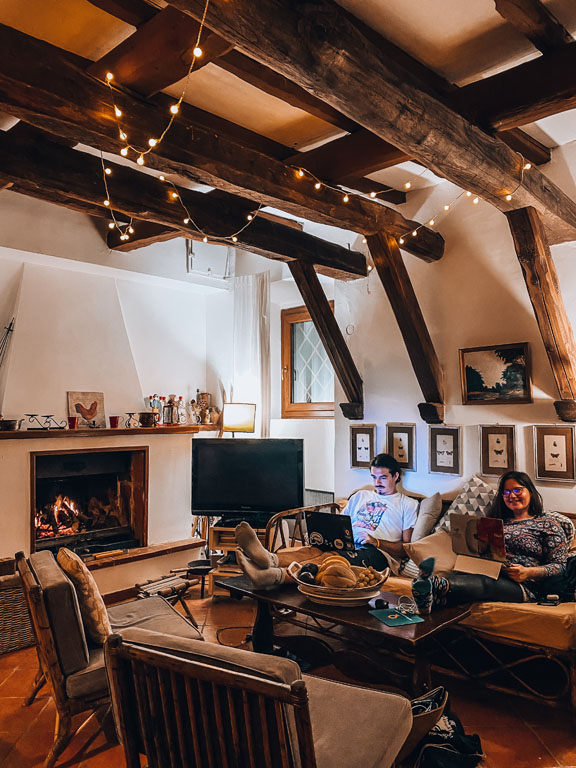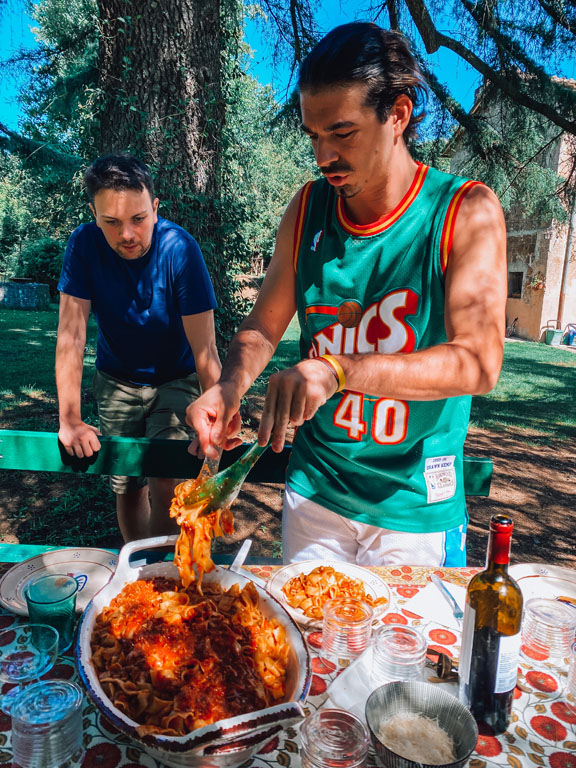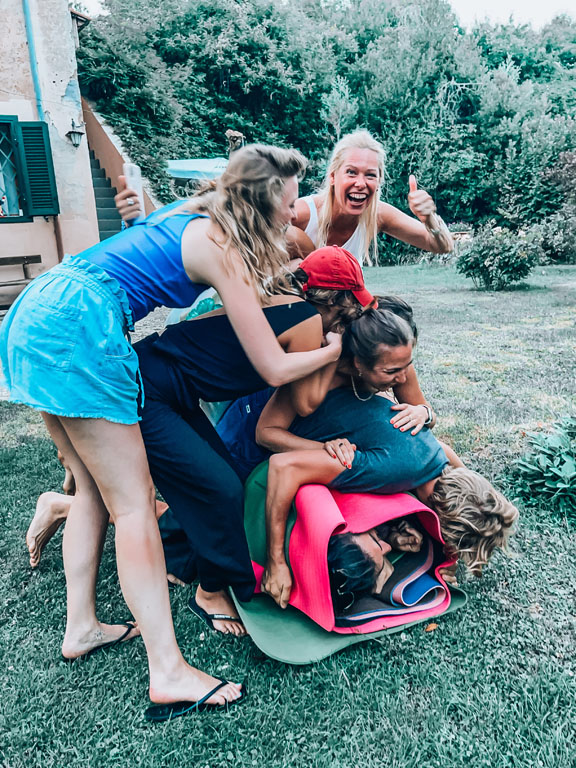Welcome to the second part of the My Coliving Space interview with The Eatinerant, rural coliving in a beautiful Lazio region of Italy.
If you haven’t read the first part, we suggest you go there before continuing to this one. In the first part, we talked about The Eatinerant and Ola and Fede’s journey to deciding to open a coliving in Italy.
In the second part, we talk about coliving in general, the community, goals, and how to approach coliving to answer some of the most pressing needs of today’s world.
There are quite a few components of a coliving that can directly asses some visible issues today, like the lack of community and connections, the struggle to maintain a healthy work-life balance, and the abandonment of small towns and rural areas.
Read below how The Eatinerant, the newest coliving in Italy, will assess these needs and how they approach their inspiration behind opening a coliving and managing it so it can positively affect their future visitors and the local community of Capranica.
Enjoy!
Community
1. Speaking of the people, based on the retreats you hosted so far and your expectations, how do you imagine the average profile of your future coliver?
Ola: Right now, we see a little difference between people interested in and coming to retreats and those interested in coliving.
What we see for the coliving, is that the age group is a bit older, so on average, maybe 35 years old. And we also see that people who are applying for co-living, are more self-established. So, they are already either working freelance for some time or they have their own business but are in general a bit more established in that area.

So, they already know that they’re coming to work on their own projects, and the coliving is mostly solving the community part for them. Mostly, they have already been nomadic or working remotely for some time, and they, as many of us, and I guess you can also agree, feel the lack of a community of like-minded people.
People are not necessarily working in the same niche, but most are working online, so you share experiences, like how to host a webinar, for example. It doesn’t matter in which industry, but you can share the technicalities or how you organize your time when you travel and things like that. All this stuff only people who actually go through them can understand.
Fede: Overall, both for the retreats and the colivings, we are looking for, first of all, good people, positive and driven, digital nomads, location independent, freelancers, entrepreneurs, and so on.
2. And you mentioned on your website that the minimum stay in the coliving will be 15 days. What do you think is a perfect amount of time for a coliver to fully experience The Eatinerant?
Fede: We think the perfect stay is one month. When we launched the project, the minimum was one month, but after talking to other colivings and getting feedback from prospects, we concluded that 15 days would’ve been better. So that’s why we reduced it to 15 days.
But we still believe that if you want to experience fully all the activities without stressing or rushing, one month is perfect. So, if one week you want to go to Tuscany, the next to Rome, and the third week, somewhere else, you have time for all of it and you can experience the local culture.

Ola: Right now, everyone who signed up so far, booked for at least one month or longer. So, so far, we don’t have people who will stay only 15 days.
But the decision also comes from feedback from a lot of people from the US who have limitations on the amount of time they can spend in the Schengen zone, and maybe they don’t necessarily want to spend 30 days out of 90 just in one place. So, that’s another reason why we decided we’re going to be more flexible. But, as I said, so far, no one booked just 15 days.
Generally about coliving
3. Do you think coliving is only dedicated to a specific group of people such as freelancers, digital nomads, and remote workers, or do you think there is a possibility for it to gain popularity beyond that group?
Fede: We think those are the most typical colivers. But it really depends. It doesn’t really matter if you are working nine to five or from the office and you want to take a month-long vacation, or you are allowed to work remotely for one period and you can travel a bit. You don’t have to be a nomad or remote worker. I mean, eventually, we would expect that we would attract non-remote workers and other types of people as well.
Ola: I think, overall, it’s better, at least to start with a certain profile of people because then there is a common understanding. For example, you can have quiet hours during working hours. That’s the basic understanding that at one time of the day, everybody is working. It’s also the different vibe in the villa.
When you go on vacation or just travel during annual holidays as an office employee, of course, you want to pack it with more events and things. But, if it’s more a lifestyle, like when you’re living on the road, you see the discovery of a country differently. You don’t have this feeling of rush that you have to make everything happen and make 40,000 steps every day and see everything.
You also understand that even if you’re in a different country, you still need to maintain your routines. Maybe some weekends I just want to stay home and watch Netflix and not feel guilty about it.
4. How much do you think a coworking space is important for coliving and why?
Ola: I think co-working is really important from the perspective that when you see other people working around you, it also gives you this extra motivation to work. So, you can have something like your accountability buddies right there on the spot. You can have one, or two hours of deep work altogether.
And then, just in general, you can kind of imitate the office atmosphere, but still, be way more relaxed.
I think with the pandemic, we all felt that it’s great to work remotely and travel, but we realized we still miss that office vibe or the “water cooler conversations”, the little chit chats between the projects or between the meetings just to kind of offload in between.
5. And what do you think is the most crucial element of coliving from your perspective?
Ola: The most crucial are the people, I think.
Coliving is always a leap of faith. Even if you go to a very popular and established coliving, but especially when you go to a newer coliving because you’re just going there to share your space with strangers.

So, I think like every coliving owner or host should put extra effort into selecting the right people because then that’s what matters. As you previously said, coliving should kind of imitate your home. And, we are usually pickier with people who we invite into our homes and the ones that will stay in our homes.
So that’s the main idea – that you have the home feeling that you’re going to share with strangers but these strangers will turn into friends or close connections.
A little bit more about The Eatinerant
6. Which uniqueness do you think The Eatinerant will offer compared to other similar places in Europe?
Ola: For me as a foreigner in Italy, the location is convenient because just one hour away you have Rome with two big international airports, so it’s easy to go around. And then the coliving itself is only one hour away from Rome, and an hour away from Tuscany, so you can discover Florence and all the cities that usually you would visit on separate trips.
Also, the connection with nature is really important. I see how it can increase your productivity and your overall mood. Just being outside of the city, having a proper city break, but with no rush.
Fede: For me as an Italian, the reason why we decided to start retreats here and create a community here was to show others my country and hometown and the area.
I’d say the problem is that people don’t know the upper parts of Italy. They know Florence and Rome and they miss all the middle parts. And there is a lot of variety in terms of food and culture in just a few kilometers and you can experience all of that, which is just amazing.
I think this area is one of the best in terms of how people are warm and how you can eat well and just experience so many different flavors in doing only 15 kilometers. You can easily swap regions and be in Tuscany in no time and drink the best wine.
So, for me, it’s also really important to promote the local culture because it is not a very known part and there’s a lot to discover: ancient castles, old towns, lakes, it’s super close to the seaside as well…

You can do so much here. And if you stay for a month, you can do everything. You’re not going to miss out on the community, you are still going to be in an amazing place, surrounded by nature, and eat like a king.
7. Are there discounts for people who either stay in coliving and then want to do some retreats (and vice versa)? And do you have some discounts for longer stays, couples, or off-season?
Ola: Currently, we don’t discount for the off-season because we also need to see how it’s going to work. Ideally, you want to increase prices during summer, but with current electricity and gas prices, actually, winter rent is quite expensive as well, so that’s why we don’t have that much flexibility on the seasonality at the moment.
But of course, if people want to stay longer than a month, we provide them with a discount because we want to encourage them to stay longer. In the end, it’s way better for the community when people stay and connect.
Of course, we’re not going to accept people to stay just one week because we don’t see it being beneficial for the rest of the participants who are staying longer, we see it maybe even being a bit disruptive for the rest of the group.
Fede: If you come in with a friend or a couple, the second person pays half of the price. That’s also what we’re offering.
8. Lastly, how do you see The Eatinerant developing in the next few years? Do you have a vision of what it will grow into or some aspirations and goals that you’ve set for it?
Ola: It’s still early, but we still see colivings popping up. We also see that the overall trend started with Covid. Before, all the young people were going to big cities for job opportunities. Now job opportunities are not in the cities anymore. So, now the main advantage of living in a big city is going down and we see more and more young people actually choosing to live more in nature or on smaller islands, close to the seaside, or even in the middle of mountains or forests.
We see this overall trend of young people going away from the cities. And of course, young people, in their twenties, or thirties, still want to feel connected with others. So that’s where the colivings come into the picture. They are solving this issue and giving you a chance to stay in a small city and have all these advantages of a small city like clean air and more cultural environment, but still have a little community of foreigners and other workers that you can learn from and grow together with.
Fede: I also think it’s still early, but what we really want to do is bring a community into upper-level Italy.
Our goal is really to grow the community in Italy, or at least where we’re staying, in our region, because it is still low. It’s not as nearly close to Spain or Portugal. So why not grow this community while doing other bigger projects in the villages around, thinking of starting more colivings like this one and growing the community?

The reason why we started this, as we were saying before, is mainly to share this lifestyle. So, we really enjoy it and it’s so beneficial from every point of view, and we think everyone should get the chance to live in this way, as nomads do because it’s just amazing.
Ola: And also, the nomad community is very non-judgmental and supportive. In the big cities, people tend to live more individualistically, and now we see this trend kind of coming a little bit from the past, where people want to live more as a commune.
But, speaking of the advantage now as compared to co-living pioneers that had it very complicated to explain the concept, what it was, and what it was going to be happening at the property – now, that the governments are more involved with digital nomads visas and are interested in more and more projects like these, of course, with their support and budget, you can do way bigger things.
